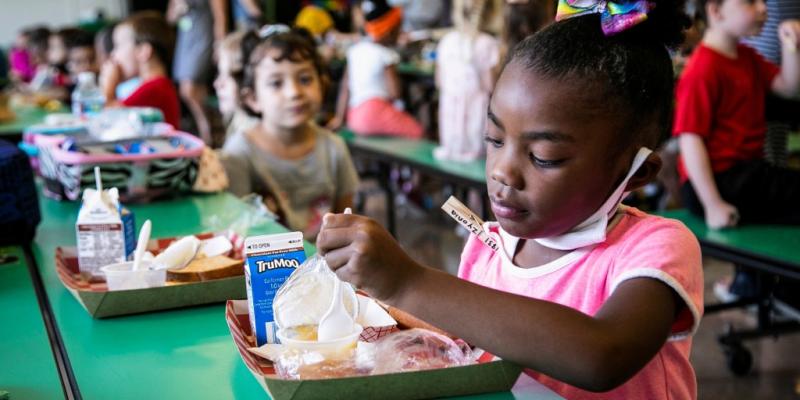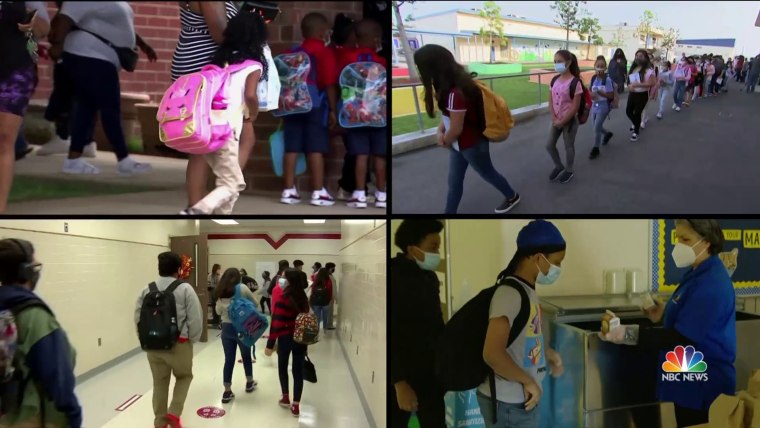Supply chain issues, labor shortages make serving school lunches a struggle



Debilitating supply chain disruptions have upended the beginning of the school year for districts across the country as food shortages force officials to find creative ways to adequately feed children.
In Alabama, it has led staff at Gulf Shores City Schools to acquire food from different vendors, shop at grocery stores and even cook meals themselves.
In Wisconsin, the Manitowoc Public School District said proteins like chicken are in short supply, while a truckload of hamburger patties never showed and a bakery supplier said it was out of hot dog buns.
And in Indiana, a school district outside of Fort Wayne says it's not only having trouble procuring certain foods but disposable trays, silverware and condiments, too.
The problems stretch from farm to cafeteria table, worsened by the pandemic and greater economic forces: A labor shortage has affected the food distribution and production industries. There's not enough workers on production lines, in warehouses and driving delivery vehicles. And at schools, unfilled cafeteria positions have forced staff to serve lunches and some have stopped providing hot meals altogether.

"There are supply chain issues. Issues with food distributors. The inability to keep people employed. Driver shortages. Every week, it's like, what's next?" said Liz Campbell, senior director of legislative and government affairs at the Academy of Nutrition and Dietetics, a trade association whose membership includes registered dietitians at schools.
The problem has grown acute over the last month, prompting Agriculture Secretary Tom Vilsack on Wednesday to announce initiatives to help schools respond to supply chain disruptions, including $1.5 billion in funding and a waiver that prevents schools from being penalized if they can't meet certain federal regulatory requirements, such as serving specific types of food, because of the shortages.
School meal programs have become even more crucial during the pandemic after the U.S. Department of Agriculture said last spring that it would extend universal free lunch through this school year — a way to reach millions of children burdened by hunger and food insecurity.
Such programs have traditionally served lower-income children. Pre-pandemic, nearly 100,000 schools served lunches to 29.6 million students daily, according to the USDA. But school closings during the pandemic meant many students may not have had the normal access to meals.
This school year was supposed to be different.
"Many thought that this was going to be a transition year before things could finally get back to normal next school year," Campbell said. "But between this and the delta variant and so many other things, it's almost worse than the previous year because there was so much expectation things were going to start getting better."
A back-to-school survey by the School Nutrition Association, which represents more than 55,000 school nutrition professionals, found that 97 percent of program directors who responded were concerned about continued pandemic-related supply chain issues, with 65 percent citing "serious" concerns. The second top concern was staff shortages, according to the survey.
"Primarily we have heard that these supply chain disruptions are forcing schools to scramble to find substitute menu items when their orders aren't delivered — they are having to place additional orders at a higher cost, find new local suppliers, even work with local restaurants, or purchase items at Costco or local restaurant depots," Diane Pratt-Heavner, an association spokeswoman, said in an email. "School menus are more streamlined than the typical year, and we can expect substitutions until these supply chain issues are resolved."
However long that may take is anybody's guess.
Laticia Baudhuin, supervisor of school nutrition at the D.C. Everest Area School District near Wausau, Wisconsin, said she's been struggling to obtain certain specialty items, including lactose-free milk and soy milk. Last week she ordered a double-stacked convection oven for a school cafeteria; she was told it won't be delivered until March.
Meanwhile, she and other staff who are normally busy with administrative tasks are working in cafeterias to dish out meals.
"I don't know where all of the people are," Baudhuin said. "We've had some labor issues in the past. Being a lunch lady is really, really hard work, and unfortunately, it doesn't draw a lot of people in."
Her optimism that the school year would get off on a better footing than the previous one has dimmed.
"We can't run as quality a program," she added.
Crystal FitzSimons, director of school and out-of-school time programs at the Food Research & Action Center, a nonprofit focused on eliminating poverty-related hunger, said one upside this year has been that the federal government offering free meal programs to all students — putting a halt on instances of students being shamed over school lunch debt.
But now, school officials' concerns over their ability to provide hot and healthy meals to all students presents yet another challenge to already overwhelmed educators.
"Part of the story of the pandemic is that we are constantly trying to catch up," FitzSimons said. "Things have just not gone back to normal."




The government has helped create a perfect storm of labor/cost issues.
1.) Offering more $$ in unemployment than many folks could make in their normal job. People are now having a hard time going back to those jobs. The States and Fed have helped dig a hole it will take months, maybe years to come out of.
2.) Not concentrating on fixing supply side issues but endlessly pushing their partisan nonsense which fixes nothing.
3.) Scaring the shit out of people, using COVID-19, so bad that people don't want to go back to work.
All of this forces every day costs higher. Food cost are higher, energy costs are higher, service costs are higher, labor costs are higher, etc. That is if you can find any of it .... all hitting every American squarely in the pocketbook. The cost of most everything is higher which is driving inflation to 30 year highs.
I see little to no government action that seriously addresses any of this. Meanwhile politicians like AOC are going to $35,000 a plate gala's wearing custom "tax the rich" dress.
If only it was all only a bad dream .....
Spot on. I don't believe this is an accident, though. Not entirely. I think there is an element somewhere that wants things like this to happen. They want a total collapse or near total so that when people are desperate enough, they can step in with their own sort of government and we won't have any choice but accept it. I feel this way because congress has to see these problems as well as we do and, as you say, do nothing to address anything. In fact, they seem to be working to make it worse.
I agree but they are underestimating much of their audience.
Just like they did in 2016 ......
People need to shop with more care, particularly on groceries. It is easy to spend less money on groceries. Buy items that are on sale, buy smaller packages of chips, etc, buy generic products (which often have exactly the same ingredients as brand names.) Buying groceries smarter would not only negate the effects of inflation, it would get their grocery bills down below the level of pre-inflation cost.
How does that, for example, solve the labor shortage? I could go on but don't really need to. The labor issue affects all up and down the supply chain for all industries. Fast food workers for example who were making 10-12 $/hr around here just a couple years ago are now making 50-100% more right now. Up to 20 $/hr starting with paid bennies. And they still can't find enough workers so are forced to cut back operating hours.
Not sure how more frugal shopping is going to solve that problem John.
It will save individual families money at a time they are complaining about inflation.
what ever happened to "brown bagging"? and the inevidable lunchroom trades ?
Anyone wanna trade for my pimento loaf and munster cheese sammy? and no cheap chips please ....
Depends, mustard or mayo? I got Doritos...
My Ma used to make this killer braunschweiger and government cheese sandwich on Wonder Bread. Little bit of yellow mustard, some mayo and that thing was major trading fodder for folks who like that meat.
You could get a sandwich, a bag of fritos, a couple ice cream sandwiches and maybe a pudding cup for just the sandwich.
Should have been cooking meals themselves all along - along with offering a salad bar in high school.
There should be zero vending machines with any kind of junk food on any school campus.
Schools make big $ for placing vending machines.
Disgusting isn't it?
And our kids suffer the health consequences.
My kids were raised on real food mostly and liked it. Luckily, there were enough students in their school who also wanted better choices so we got a salad bar for the high school kids. I don't remember if soup or sandwiches were an option, but they should have been.
Salad/soup/sandwiches cheap, filling and nutritious options with minimum labor involved.